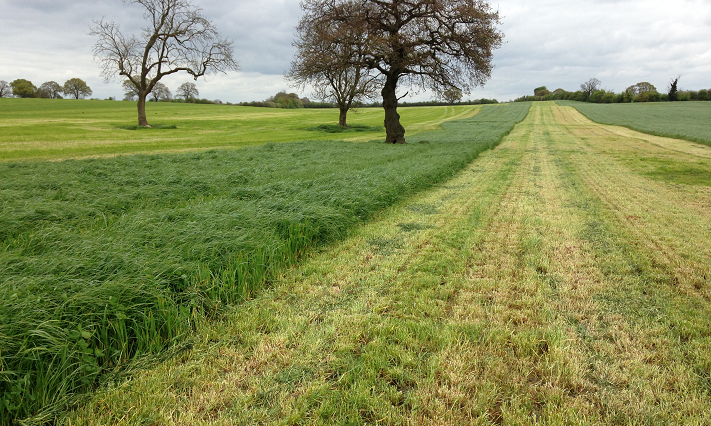Medley of forages ensures full clamps
Red clover mixture lies at centre of James Brown’s dairy system
Tenant farmer James Brown milks 490 cows split into two herds. One, with 350 animals, produces conventional milk, while the other produces a2 milk, for which there is now increasing consumer demand.
He farms 255ha (625 acres) at Lower Barton Farm on the Bradford Estates near Bradley in Shropshire. The soil is silty clay loam and is mainly free-draining. One hundred and forty-two hectares (350 acres) has a grass crop growing on it to supply conserved forage and zero grazing, fed to the cows that are housed and calve all year round.
At the centre of the forage plan is a red clover/perennial ryegrass/ festulolium/white clover medium term seeds mixture, which is down for four or five years and used as an entry for a following wheat crop.
The grass provides a clean entry for the cereal and leaves high fertility behind, allowing Mr. Brown to achieve at least 9.8 tonnes/ha (4t/acre) of wheat off 120kg/ha (150 units/acre) of N applied. The wheat is processed either as wholecrop or as grain, using a urea-based additive, which is all fed to the cows.
“I introduced red clover into the grass mix three years ago and it has been transformational,” says James Brown. “The grass and the wheat work so well together. I mostly do one year of wheat, occasionally two.
“The grass is sown in the autumn after the wheat has been harvested. Last year I drilled Broadsword Hi Pro and have been impressed by how much feed it has given us.”
 Broadsword Hi Pro being zero grazed
Broadsword Hi Pro being zero grazed
Mr. Brown feels the best way to establish the red clover mix is not to plough. Rather a contractor comes in and discs the wheat stubble down to two or three inches in depth, which makes a seedbed on which the clover seed can safely lie.
If the seedbed is weedy, particularly with couch, the field may be sprayed with herbicide, before it is drilled with a Lemken Soladisc. It is drilled in one direction, using tramlines that Mr. Brown has put into all his fields – grass and cereals.
After drilling, the field is rolled. The grass seed has germinated and is clearly visible within a week. It is left to grow through October and November before sheep are brought in on tack. These are mob-grazed behind an electric fence, which is regularly moved, until the end of January. The field is left for a month, before 9,800 gallons/ha (4,000 gallons/acre) of slurry are applied as soon as soil conditions allow in March. If it is wet, rather than running over the ground with a heavy tanker, a contractor with an umbilical system and liquid fertiliser spreader is hired.
Towards the end of March, there may be enough grass growing to start zero grazing. The nutritionist measures the fields every week through the growing season. Once there is more than 3,500kg dry matter per hectare (DM/ha) growing, the crop is harvested using a front-mounted mower with forage wagon behind the tractor.
The cows are given 10 to 15kg of fresh grass to start, building up to 26kg a day by early April. Zero grazing continues until the end of September or early October.
During the summer, when grass growth exceeds the 3,500kg DM/ha mark, areas of the field are left to keep on growing and are cut for silage. Mr. Brown aims to take four cuts of high quality material, making 2,500 tonnes in total.
Slurry is applied at a rate of 4,900 to 7350 gallons/ha (2,000 to 3,000 gallons/acre) after each cut, using a trailing shoe applicator, which prevents contamination of the grass that will be taken for zero grazing and reduces nutrient losses to the atmosphere.
The second and third years of grass and clover follow the same pattern – with the last cut in mid August before being ploughed. This brings the leguminous nodules to the surface, ready to feed the next wheat crop, which is drilled by the 15 September.
Back to maize
Last year Mr. Brown went back into growing 20ha (50 acres) maize after a few years away from it, on a newly rented farm with small fields. Growing maize will help fertility-build low nutrient soils with farmyard manure and slurry and the silage will dovetail well with the high protein red clover forage.
“We try and keep the diet consistent throughout the year – feeding a mix of forages, alkagrain, pressed pulp to boost butterfat, liquid lactose to balance the protein and some blend. The cows also receive cake in the 50-point rotary parlour. But at the centre of everything is the red clover grass mixture and without that, the system just would not work.”
This article first appeared in the February 2018 issue of British Dairying.
